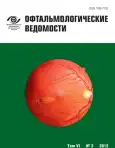The oxygen-induced retinopathy as an experimental model of retinopathy of prematurity
- Authors: Konikova O.A.1, Brzheskiy V.V.1, Fedotova Y.P.1, Nasyrov R.A.1
-
Affiliations:
- St-Petersburg State Pediatric Medical University
- Issue: Vol 6, No 3 (2013)
- Pages: 37-42
- Section: Articles
- URL: https://journals.rcsi.science/ov/article/view/336
- DOI: https://doi.org/10.17816/OV2013337-42
- ID: 336
Cite item
Full Text
Abstract
Keywords
About the authors
Olga Aleksandrovna Konikova
St-Petersburg State Pediatric Medical University
Email: olgakonikova@gmail.com
department of ophthalmology
Vladimir Vsevolodovich Brzheskiy
St-Petersburg State Pediatric Medical University
Email: vvbrzh@yandex.ru
head of department of ophthalmology
Yelena Pavlovna Fedotova
St-Petersburg State Pediatric Medical University
Email: kris6060@mail.ru
department of ophthalmology
Ruslan Abdulayevich Nasyrov
St-Petersburg State Pediatric Medical Universityhead of department of pathological anatomy
References
- Бызов А. Л. Физиология сетчатки: нейромедиаторы и электрогенез // Клиническая физиология зрения: Сборник научных трудов. М.: «Русомед», 1993. — С. 12–27.
- Зуева М. В., Цапенко И. В. Электрофизиологическая характеристика глиально-нейрональных взаимоотношений при ретинальной патологии // Сенсорные системы. — 1992. — № 3. — С. 58–63.
- Зуева М. В., Цапенко И. В. Методика регистрации ритмической ЭРГ и перспективы ее развития в клинике глазных болезней // Клиническая физиология зрения, сборник научных трудов. М.: «Русомед», 1993. — С. 83–101.
- Катаргина Л. А. Современное состояние проблемы ретинопатии недоношенных и задачи по улучшению офтальмологической помощи недоношенным детям в РФ // Сборник научных трудов Всероссийской научно-практической конференции «Ретинопатия недоношенных 2011». — М., 2011. — С. 5–10.
- Нероев В. В., Зуева М. В., Каламкаров Г. Р. Молекулярные механизмы ретинальной ишемии // Вестник офтальмологии. — 2010. — № 3. — С. 59–63.
- Akula J. D., FavazzaT. L., MockoJ. A. at al. The anatomy of the rat eye with oxygen-induced retinopathy // Doc. Ophthalmol. — 2010. — Vol. 120. — P. 41–50.
- Bringmann A., Iandiev I., Pannicke T. et al. Cellular signaling and factors involved in Muller cell gliosis: Neuroprotective and detrimental effects // Progress in Retinal and Eye Research. — 2009. — Vol. 28. — P. 423–451.
- Cairns J. E. Normal development of the hyaloid and Retinal vessels in the rat // Brit. J. Ophthalmol. — 1959. — Vol. 43. — P. 385–393.
- Calogero G., Ricci B. Experimental oxygen-induced retinal detachment in the newborn Wistar rat // Doc. Ophthalmol. — 1994. — Vol. 87, N 4. — P. 315–329.
- Cringle S. J. Yu Dao-Yi. Oxygen supply and consumption in the retina: implications for studies of retinopathy of prematurity // Doc.Ophthalmol. — 2010. — Vol. 120. — P. 99–109.
- Dembishka O., Rojas L. M., Varma D. R. et al. Contribution of retinal maturation to the development of oxygen-induced retinopathy in rats // Invest. Ophthalmol. Vis. Sci. — 2001. — Vol. 42, N 5. — P. 1111–1118.
- Dorfman А., Dembinska О., Chemtob S., Lachapelle P. Early manifestations of postnatal hyperoxia on the retinal structure and function of the neonatal rat // Invest. Ophthalmol. Vis. Sci. — 2008. — Vol. 49, N 1. — Р. 458–466.
- Fleicher E. L., Downie L. E. et al. The significance of neuronal and glial cell changes in the rat retina during oxygen-induced retinopathy // Doc. Ophthalmol. — 2010. — Vol. 120. — P. 67–86.
- Fruttiger M. Development of the mouse retinal vasculature: angiogenesis versus vasculogenesis // Invest. Ophthalmol. Vis. Sci. — 2002. — Vol. 43. — P. 522–527.
- Fulton A., Hansen R., Moskowits A., Akula J. The neurovascular retina in retinopathy of prematurity // Progress in retinal and eye research. — 2009. — Vol. 28. — P. 452–482.
- Jadhav A., Roesch K. Cepko C. Development and neurogenic potential of Muller glial cells in the vertebrate // Progress in Retinal and eye research. — 2009. — Vol. 28. — P. 249–262.
- Loewen N., Chen J., Dudley V. J. et al.Genomic response of hypoxic Muller cells involves the very low density lipoprotein receptor as part of an angiogenic network // Exp. Eye Res. — 2009. — Vol. 88. — P. 928–937.
- Ozkan H., Duman N., Kumral A. et al. Inhibition of vascular endothelial growth factor-induced retinal neovascularization by retinoic acid in experimental retinopathy of prematurity // Physiol. Res. — 2006. — Vol. 55. — P. 267–275.
- Penn J. S., Henry M. M., Wall P. T., TolmanB. L. The range of PaO2 variation of oxygen-induced retinopathy in newborn rats // Invest. Ophthalmol. Vis. Sci. — 1995. — Vol. 36, N 10. — P. 2063–2070.
- Ramirez J., Triviño A., Ramirez A. et al. Structural Specialization of Human Retinal Glial Cells // Vis. Res. — 1996. — Vol. 36. — P. 2029–2036.
- Smith L. Pathogenesis of retinopathy of prematurity // Growth Hormone & IGF Research. — 2004. — Vol.14. — P. 140–144.
- Ştefănuţ A. C., Miclăuş V., Mureşan A. et al. Retinal neovascularisation in newborn rats submitted to variations of concentrations of oxygene. Histopatological aspects // Veterinary Medicine. — 2010. — Vol. 67, N 1. — P. 305–314.
- Stefanut A. C., Talu S., Milcaus V. et al. Fractal analysis study of retinal development in Rats exposed to the alternating hyperoxia-hypoxia // Annals of the Romanian Society for Cell Biology. — 2013. — Vol. 18, N 1 — P. 239–246.
- Wijngaarden P., Douglas J. C., Brereton H. M. et al. Strain-dependent differences in oxygen-induced retinopathy in the inbred rat // Invest. Ophthalmol. Vis. Sci. — 2005. — Vol. 46, N. 4. — P. 1445–1452.
Supplementary files







